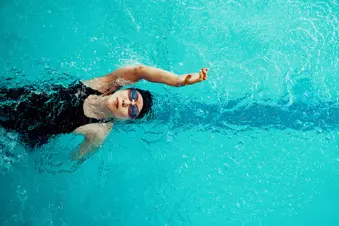
By Kate Tatar, as told to Hope Cristol
I wasn’t really an athletic kid, but that started to change in high school when I joined my brother on a camping trip. It was my introduction to hiking and backpacking and I fell in love.
When I went to college, I was really active with the MIT Outing Club [a multi-sport group of outdoor enthusiasts]. I also learned to rock climb and swing dance. And when I got my first job out of college, I would hike after work, go climbing or swing dancing once or twice a week, and work out at the gym.
I remember thinking one day at the gym, “Wait a second. I’m so active!” That had never been part of my personal identity. I always thought of myself as awkward, nerdy, clumsy.
By the time I was 25, (I’m 28 now) my body started to have problems that most other 20-somethings didn’t. I’d get an injury, recover, and then have pain somewhere else. I had a very stressful job and didn’t get enough sleep or eat very healthy. Even after I quit, I kept having new joint pain, so I saw a rheumatologist.
Bloodwork showed some red flags for rheumatoid arthritis (RA), but not enough for a diagnosis, so I had to figure out a way to still be active and do activities I enjoy. I learned a lot through trial and error.
Today, I have an RA diagnosis and am on a biologic that’s working. That’s a big part of what lets me set and achieve physical goals like major hikes and climbs. Right now I’m training for the California Coast Classic, a fundraising bike ride for the Arthritis Foundation.
Here’s what I’ve learned about staying active with RA.
Basic lifestyle changes help a lot. When I focus on sleep, healthy food choices, and rest when my body needs it, I really can do more. I’m less likely to push myself hard enough to cause a flare, and I have more energy to be active when I don’t wear myself out being frustrated.
Try prenatal workouts. Even when you’re not pregnant, they’re the perfect way to start back up with fitness again, or to keep your body in shape on days when you can’t do too much. There are so many online. If you’re having a bad day, you can find a 10-minute one that’s really low impact. Some of the longer ones out there are hard even for me!
Don’t write off bad arthritis days. I had some days where it was really hard to walk for hours after I woke up. I learned to be kind to myself and say, OK, this is how my body’s reacting, I just have to work with it. Sometimes if I waited for the ibuprofen to kick in instead of pushing through the pain or getting mad about it, I’d be able to have a regular day after all.
You can overdo “restorative” activities. Before I started on DMARDs, I managed to trigger my worst flare-up by getting a massage and then immediately doing yoga. The seemingly restorative exercise resulted in horrible shoulder pain. More isn’t always better.
Pilates reformer machines work for me. [You use them in] a structured class. It’s less boring than my physical therapy exercises, targeting the muscles to support my joints without aggravating my joints and tendons in the process. [The classes are] expensive but worth the money for me.
The boring drug-free solutions help. I know some people recommend diets and supplements and say it really helped them. I tried a lot of different natural remedies and none of them really made a difference. Other than ibuprofen and now, my biologic, the things that make my joints feel better are braces, ice, foot soaks, and help (like help lifting or twisting open water bottles).
Take the drugs. Even before I went on RA drugs, ibuprofen was the key to living an active life --not the soothing foot soaks or foot massagers, the acupuncture, or all the diets I tried. I try to supplement with alternatives to give my body its best chance at thriving, but effective medication means I can hike and backpack without having to distract myself from pain.
Find a fitness tracker with useful insights. I have one that tracks things like respiratory rate, skin temperature, blood oxygen, heart rate, and sleep. It uses these to give you a recovery percentage and a strain score. I don’t think it’s 100% accurate, but I see it as a guide to helping me listen to my body -- to help me pay attention to when I can try harder or when I need to rest.
Your mindset matters. Having done a lot of personal work on my mental health made it much easier to cope with my physical health conditions. The more I started to accept that this is where I am and what I can do, and the less I dwelled on all the stuff I was missing, the better I felt.
I still sometimes beat myself up about how hard it is for me to do things that used to be easy before the joint issues. It’s easy to be sad and unmotivated in that mindset. I try to focus on what I can do and accomplish, and the tangible steps I can take. Some days the fatigue is bad and I can’t go on an intense adventure, but I can still enjoy being outside on a gentle trail with my dog.
I have quite a few “work hard, play hard” friends. If I compare myself to those ultramarathoner peers, I’m always losing. If I am gentle with myself and practice gratitude for beautiful views and joyful movement of being active, every day can be a win even if it’s hard.
Show Sources
Photo Credit: Trevor Williams / Getty Images
SOURCES:
Kate Tatar, recreational athlete living with RA, San Francisco.
MIT: “MIT Outing Club.”